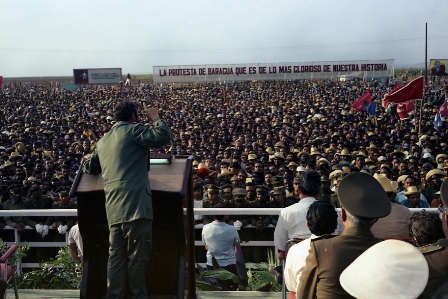
Fernando Dámaso, 14 March 2018 — Once again, as every March 15, the Protest of Baraguá is exalted as a transcendental event in our history, which “demonstrates Cubans’ vertical refusal to accept defeat and their tenacity.”
The gesture of Antonio Maceo and his followers of the Cuba Division, to not accept the peace agreed upon in El Zanjón by the majority of the insurgent leaders, although arrogant and brave, did not address the real situation of the war and of the opportunities to continue it at that moment, where the regional caudillismo proliferated, the fatigue of ten years of struggle without achieving victory and exhaustion and loss of interest in providing the necessary resources, for the emigration that supported and sustained it economically.
With regards to the situation prevailing at that time, Enrique Collazo, in his work “From Yara to the Zanjón,” states: “Peace was a necessity imposed by circumstances, since the insurgents were, according to Sanguily, exhausted, decimated, disenchanted, hungry, without ammunition and without faith.”
Subsequent events confirmed it: fifty-five days after Baraguá, on May 9, Maceo agreed to cease the fight and left Cuba for Jamaica in the Spanish gunboat “Fernando el Católico,” placed at his disposal by General Martínez Campos, the same one who had offered to sign the peace in Baraguá.
Eight days later Lieutenant Colonel Lacret, who had accompanied Maceo on his trip to Jamaica, returned with the conviction that the cause of Cuba was lost and that no resources should be expected from abroad (in Jamaica they had only seven men had signed up to come to Cuba, and the collection to acquire weapons and ammunition added the derisory amount of five shillings, that is, ten reales of the time). On May 28, with the exception of Limbano Sánchez, Leocadio Bonachea and some others, all of the “Baraguá protestors” accepted the Pact of Zanjón and laid down their arms.
Máximo Gómez and those who had accepted the Pact of Zanjón from the beginning (they knew the reality of the situation and acted in correspondence with it), were accused disparagingly of being “zanjoneros” for a long time.
Later Maceo settled in Costa Rica and became a prosperous landowner. Máximo Gómez returned to Santo Domingo and dedicated himself to tilling the land.
Martí praised the gesture, with the aim of mobilizing Cubans for the new war he organized, intelligently linking the men of ’68 with the new generation. However, to achieve his goals, he needed to unite the “zanjoneros” (Máximo Gómez) with the “Baraguá Protestors” (Antonio Maceo), without whom the new contest would have been impossible.
But good intentions are not enough to ensure a good decision: Baraguá is an example. Our most recent history is lavish in stubbornness.
